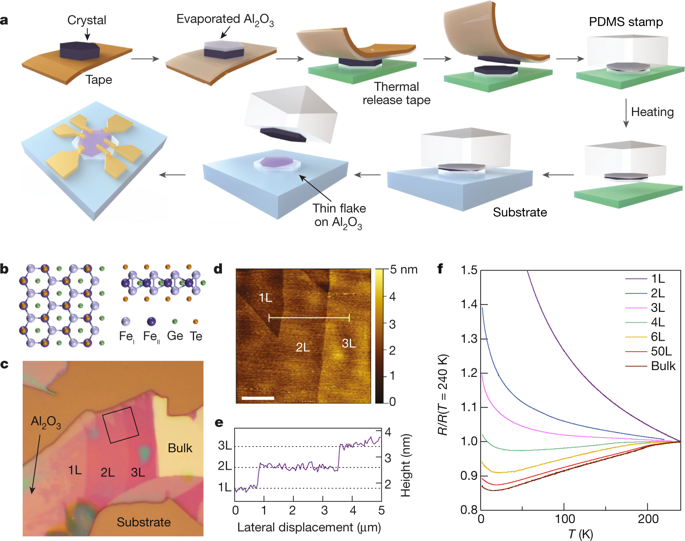Our official English website, www.x-mol.net, welcomes your
feedback! (Note: you will need to create a separate account there.)
Gate-tunable room-temperature ferromagnetism in two-dimensional Fe3GeTe2
Nature ( IF 50.5 ) Pub Date : 2018-10-22 , DOI: 10.1038/s41586-018-0626-9 Yujun Deng , Yijun Yu , Yichen Song , Jingzhao Zhang , Nai Zhou Wang , Zeyuan Sun , Yangfan Yi , Yi Zheng Wu , Shiwei Wu , Junyi Zhu , Jing Wang , Xian Hui Chen , Yuanbo Zhang
Nature ( IF 50.5 ) Pub Date : 2018-10-22 , DOI: 10.1038/s41586-018-0626-9 Yujun Deng , Yijun Yu , Yichen Song , Jingzhao Zhang , Nai Zhou Wang , Zeyuan Sun , Yangfan Yi , Yi Zheng Wu , Shiwei Wu , Junyi Zhu , Jing Wang , Xian Hui Chen , Yuanbo Zhang

|
Materials research has driven the development of modern nano-electronic devices. In particular, research in magnetic thin films has revolutionized the development of spintronic devices1,2 because identifying new magnetic materials is key to better device performance and design. Van der Waals crystals retain their chemical stability and structural integrity down to the monolayer and, being atomically thin, are readily tuned by various kinds of gate modulation3,4. Recent experiments have demonstrated that it is possible to obtain two-dimensional ferromagnetic order in insulating Cr2Ge2Te6 (ref. 5) and CrI3 (ref. 6) at low temperatures. Here we develop a device fabrication technique and isolate monolayers from the layered metallic magnet Fe3GeTe2 to study magnetotransport. We find that the itinerant ferromagnetism persists in Fe3GeTe2 down to the monolayer with an out-of-plane magnetocrystalline anisotropy. The ferromagnetic transition temperature, Tc, is suppressed relative to the bulk Tc of 205 kelvin in pristine Fe3GeTe2 thin flakes. An ionic gate, however, raises Tc to room temperature, much higher than the bulk Tc. The gate-tunable room-temperature ferromagnetism in two-dimensional Fe3GeTe2 opens up opportunities for potential voltage-controlled magnetoelectronics7–11 based on atomically thin van der Waals crystals.Monolayers of Fe3GeTe2 exhibit itinerant ferromagnetism with an out-of-plane magnetocrystalline anisotropy; ionic gating raises the ferromagnetic transition temperature of few-layer Fe3GeTe2 to room temperature.
中文翻译:

二维 Fe3GeTe2 中栅极可调的室温铁磁性
材料研究推动了现代纳米电子器件的发展。特别是,磁性薄膜的研究彻底改变了自旋电子器件的发展 1,2,因为识别新的磁性材料是提高器件性能和设计的关键。范德华晶体保持其化学稳定性和结构完整性直到单层,并且原子级薄,很容易通过各种门调制 3,4 进行调整。最近的实验表明,可以在低温下在绝缘 Cr2Ge2Te6(参考文献 5)和 CrI3(参考文献 6)中获得二维铁磁有序。在这里,我们开发了一种器件制造技术,并将单层与层状金属磁体 Fe3GeTe2 隔离,以研究磁传输。我们发现流动的铁磁性在 Fe3GeTe2 中一直持续到具有平面外磁晶各向异性的单层。相对于原始 Fe3GeTe2 薄片中 205 开尔文的体积 Tc,铁磁转变温度 Tc 受到抑制。然而,离子门将 Tc 升高到室温,远高于体 Tc。二维 Fe3GeTe2 中栅极可调的室温铁磁性为基于原子级薄范德华晶体的潜在压控磁电子学 7-11 开辟了机会。 Fe3GeTe2 的单层表现出具有面外磁晶各向异性的流动铁磁性;离子门控将少层 Fe3GeTe2 的铁磁转变温度提高到室温。相对于原始 Fe3GeTe2 薄片中 205 开尔文的体积 Tc,铁磁转变温度 Tc 受到抑制。然而,离子门将 Tc 升高到室温,远高于体 Tc。二维 Fe3GeTe2 中栅极可调的室温铁磁性为基于原子级薄范德华晶体的潜在压控磁电子学 7-11 开辟了机会。 Fe3GeTe2 的单层表现出具有面外磁晶各向异性的流动铁磁性;离子门控将少层 Fe3GeTe2 的铁磁转变温度提高到室温。相对于原始 Fe3GeTe2 薄片中 205 开尔文的体积 Tc,铁磁转变温度 Tc 受到抑制。然而,离子门将 Tc 升高到室温,远高于体 Tc。二维 Fe3GeTe2 中栅极可调的室温铁磁性为基于原子级薄范德华晶体的潜在电压控制磁电子学 7-11 开辟了机会。离子门控将少层 Fe3GeTe2 的铁磁转变温度提高到室温。二维 Fe3GeTe2 中栅极可调的室温铁磁性为基于原子级薄范德华晶体的潜在压控磁电子学 7-11 开辟了机会。 Fe3GeTe2 的单层表现出具有面外磁晶各向异性的流动铁磁性;离子门控将少层 Fe3GeTe2 的铁磁转变温度提高到室温。二维 Fe3GeTe2 中栅极可调的室温铁磁性为基于原子级薄范德华晶体的潜在压控磁电子学 7-11 开辟了机会。 Fe3GeTe2 的单层表现出具有面外磁晶各向异性的流动铁磁性;离子门控将少层 Fe3GeTe2 的铁磁转变温度提高到室温。
更新日期:2018-10-22
中文翻译:

二维 Fe3GeTe2 中栅极可调的室温铁磁性
材料研究推动了现代纳米电子器件的发展。特别是,磁性薄膜的研究彻底改变了自旋电子器件的发展 1,2,因为识别新的磁性材料是提高器件性能和设计的关键。范德华晶体保持其化学稳定性和结构完整性直到单层,并且原子级薄,很容易通过各种门调制 3,4 进行调整。最近的实验表明,可以在低温下在绝缘 Cr2Ge2Te6(参考文献 5)和 CrI3(参考文献 6)中获得二维铁磁有序。在这里,我们开发了一种器件制造技术,并将单层与层状金属磁体 Fe3GeTe2 隔离,以研究磁传输。我们发现流动的铁磁性在 Fe3GeTe2 中一直持续到具有平面外磁晶各向异性的单层。相对于原始 Fe3GeTe2 薄片中 205 开尔文的体积 Tc,铁磁转变温度 Tc 受到抑制。然而,离子门将 Tc 升高到室温,远高于体 Tc。二维 Fe3GeTe2 中栅极可调的室温铁磁性为基于原子级薄范德华晶体的潜在压控磁电子学 7-11 开辟了机会。 Fe3GeTe2 的单层表现出具有面外磁晶各向异性的流动铁磁性;离子门控将少层 Fe3GeTe2 的铁磁转变温度提高到室温。相对于原始 Fe3GeTe2 薄片中 205 开尔文的体积 Tc,铁磁转变温度 Tc 受到抑制。然而,离子门将 Tc 升高到室温,远高于体 Tc。二维 Fe3GeTe2 中栅极可调的室温铁磁性为基于原子级薄范德华晶体的潜在压控磁电子学 7-11 开辟了机会。 Fe3GeTe2 的单层表现出具有面外磁晶各向异性的流动铁磁性;离子门控将少层 Fe3GeTe2 的铁磁转变温度提高到室温。相对于原始 Fe3GeTe2 薄片中 205 开尔文的体积 Tc,铁磁转变温度 Tc 受到抑制。然而,离子门将 Tc 升高到室温,远高于体 Tc。二维 Fe3GeTe2 中栅极可调的室温铁磁性为基于原子级薄范德华晶体的潜在电压控制磁电子学 7-11 开辟了机会。离子门控将少层 Fe3GeTe2 的铁磁转变温度提高到室温。二维 Fe3GeTe2 中栅极可调的室温铁磁性为基于原子级薄范德华晶体的潜在压控磁电子学 7-11 开辟了机会。 Fe3GeTe2 的单层表现出具有面外磁晶各向异性的流动铁磁性;离子门控将少层 Fe3GeTe2 的铁磁转变温度提高到室温。二维 Fe3GeTe2 中栅极可调的室温铁磁性为基于原子级薄范德华晶体的潜在压控磁电子学 7-11 开辟了机会。 Fe3GeTe2 的单层表现出具有面外磁晶各向异性的流动铁磁性;离子门控将少层 Fe3GeTe2 的铁磁转变温度提高到室温。


















































 京公网安备 11010802027423号
京公网安备 11010802027423号